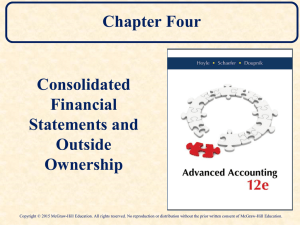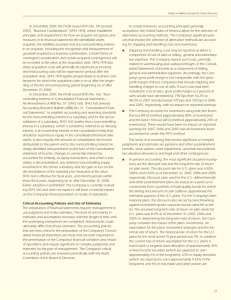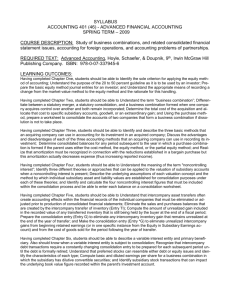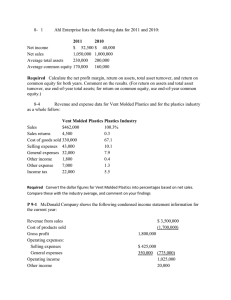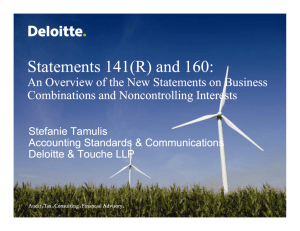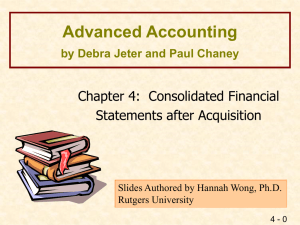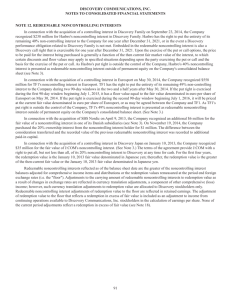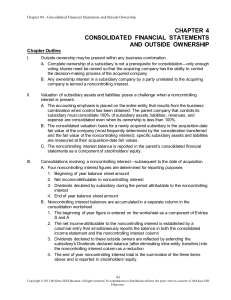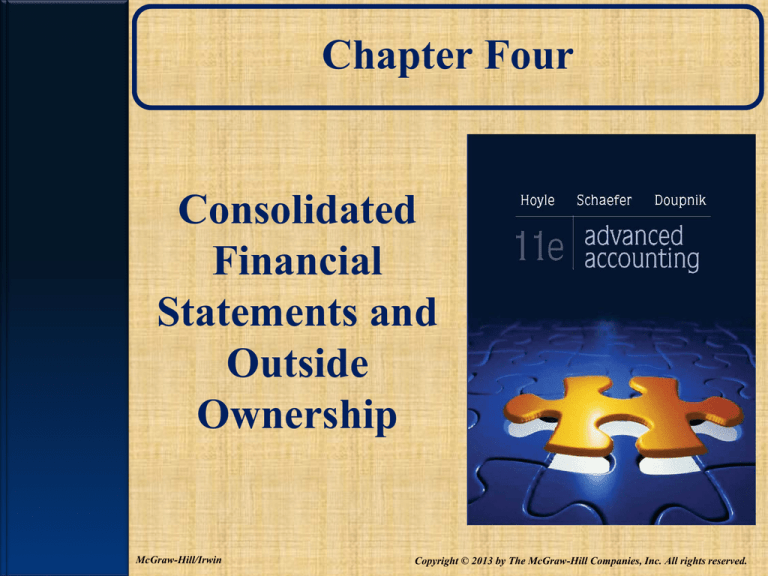
Chapter Four
Consolidated
Financial
Statements and
Outside
Ownership
McGraw-Hill/Irwin
Copyright © 2013 by The McGraw-Hill Companies, Inc. All rights reserved.
4-2
LO 1
Noncontrolling Interest
Although most parent companies do possess
100 percent ownership of their subsidiaries, a
significant number establish control with a
lesser amount of stock.
If the parent doesn’t own 100% of the
company, WHO owns the rest of it?
Noncontrolling Shareholders
The ownership interests of the Noncontrolling
Shareholders must be reflected in the
consolidated financial statements.
4-2
4-3
LO 2
Noncontrolling Interest
The Parent, with controlling interest, must
consolidate 100% of the Subsidiary’s financial
information.
The acquisition method requires that the
subsidiary be valued at the acquisition-date fair
value.
The total acquired firm fair value in a partial
acquisition is the sum of
The fair value of the controlling interest.
The fair value of the noncontrolling interest
at the acquisition date.
4-3
Noncontrolling Interest Example
Parker purchased 9,000 shares at $70 per share.
The fair value of their consideration transferred is
$630,000.
The remaining 1,000 shares trade at $60 per share
indicating that the fair value of the noncontrolling
interest is $60,000. The total acquisition-date fair
value of the sub is $690,000.
Fair value of controlling interest :
($70 X 9,000 shares) . . . . . . . . . . . . . . . $630,000
Fair value of noncontrolling interest
($60 X 1,000 shares) . . . . . . . . . . . . . . . . . 60,000
Total fair value of sub. . . . . . . . . . . . . . $690,000
4-4
LO3
Noncontrolling Interest Example
The total acquisition-date fair value (amount paid) of
Strong of $690,000 is greater than the fair value of the
identifiable net assets acquired of $600,000 (10,000
shares x $60 per share). The difference is allocated to
Goodwill.
The parent first allocates goodwill to its controlling
interest for the excess of the fair value of the parent’s
equity interest over its share of the fair value of the net
identifiable assets. ($600,000 X 90% = 540, 000).
Goodwill allocated to the controlling and
noncontrolling interests will not always be proportional
to the percentages owned.
4-5
LO4
Allocating Subsidiary’s Net Income
The subsidiary’s net income (including excess acquisition-date fairvalue amortizations) must be allocated to its owners - the parent
and the noncontrolling interest - to properly measure their
respective equity in the consolidated entity.
On the Income Statement:
An account called Noncontolling Interest in Subsidiary Net Income
represents the noncontrolling shareholders’ share of the sub’s net
income.
This account is created during consolidation and reported in the
worksheet entries.
4-6
LO 5
Noncontrolling Interests
and Consolidations
The consolidation process remains substantially
unchanged with a noncontrolling interest.
Consolidate as though the Parent has 100%
ownership.
Then determine noncontrolling interest:
in the subsidiary at beginning of the current year.
In sub’s current year net income.
In sub’s current year dividend payments.
in the subsidiary as of the end of the year.
4-7
LO 6
Consolidated Financial Statement
Income Statement
Noncontrolling interests in the equity of
subsidiaries are reported in the owners’ equity
section of the consolidated statement of financial
position.
The amount should be clearly identified, labeled,
and distinguished from the parent’s controlling
interest in its subsidiaries.
Also consolidated net income (or loss) and each
component of other comprehensive income must
be allocated to the controlling and noncontrolling
interests.
4-8
LO 7
Noncontrolling Interest –
Premium Paid
If King had paid $11.00 for their shares, at a
time when they were trading for $9.75, then
the goodwill allocation would look like this:
$9.75 x 20,000 shares
$11.00 x 80,000
shares
Acquisition-date FV
4-9
Effects of using the
Initial Value Method
The initial value method employs cash basis for
income recognition.
The parent recognizes dividend income rather than
an equity income accrual.
Parent does not accrue the percentage of the sub’s
income earned in excess of dividends (the increase in
subsidiary retained earnings).
The parent does not record amortization expense,
therefore it must include it in the consolidation
process if proper totals are to be achieved.
4-10
Effects of using the
Initial Value Method
If the Parent used the Initial Value Method to
account for the Sub after acquisition,
Entry *C is used to convert to the Equity
Method.
The entry will combine the increase in the
Sub’s Retained Earnings since acquisition X
the parent’s percentage of ownership, and the
parent’s share of amortization expense since
acquisition.
Entry D is not necessary.
4-11
Effects of using the
Partial Equity Method
If the Parent used the Partial Equity
Method to account for the Subsidiary
after acquisition, Entry *C is used to
convert to the Equity Method.
Entry *C converts from the Partial Equity
Method to the Equity Method, but only
the adjustment for the parent’s share of
amortization expense is necessary.
4-12
LO 8
Mid-Year Acquisitions
When control of a Sub is acquired at a
time subsequent to the beginning of the
sub’s fiscal year:
The income statements are consolidated as
usual
The Sub’s pre-acquisition revenues and
expenses are excluded from the Parent’s
consolidated statements (adjusted via
EntryS)
Only a partial year’s amortization on excess
fair value is taken.
4-13
LO 9
Step Acquisitions
When a Parent acquires a Subsidiary over
time, or in “steps,” the date control is
achieved is significant –
All previous values for the investment,
prior to the date control is obtained, are
remeasured to fair value as of the date of
control.
If after obtaining control, the parent
increases its ownership interest in the
subsidiary, no further remeasurement
takes place.
4-14
LO 10
Sales of Subsidiary Stock
What is reported on the consolidated
statements when a Parent sells some of its
ownership in a Subsidiary?
If the parent maintains control, it
recognizes no gains or losses – the sale is
shown in the equity section.
If the sale results in the loss of control, the
parent recognizes any resulting gain or loss
in consolidated net income.
4-15
Sales of Subsidiary Stock
If the parent retains any of its former sub’s shares,
the investment should be remeasured to fair value
on the date control is lost.
Any resulting gain or loss from the remeasurement
should be recognized in the parent’s net income.
If it sells less than the entire investment, parent
must select a cost-flow assumption if it has made
more than one purchase.
For securities, the use of specific identification
based on serial numbers is acceptable, although
averaging or FIFO assumptions often are applied.
4-16
Noncontrolling Interest –
Int’l Accounting Standards
US GAAP
U.S. GAAP requires fair
value measurement.
Thus, acquisition-date
fair value provides a
basis for reporting the
noncontrolling interest
which is adjusted for its
share of subsidiary
income and dividends
subsequent to
acquisition.
vs.
IFRS
IFRS permits fair value
measurement, or the
noncontrolling interest may
be measured at a
proportionate share of the
Sub’s identifiable net asset
fair value, which excludes
goodwill. This option
assumes that any goodwill
created via acquisition
applies solely to the
controlling interest.
4-17

